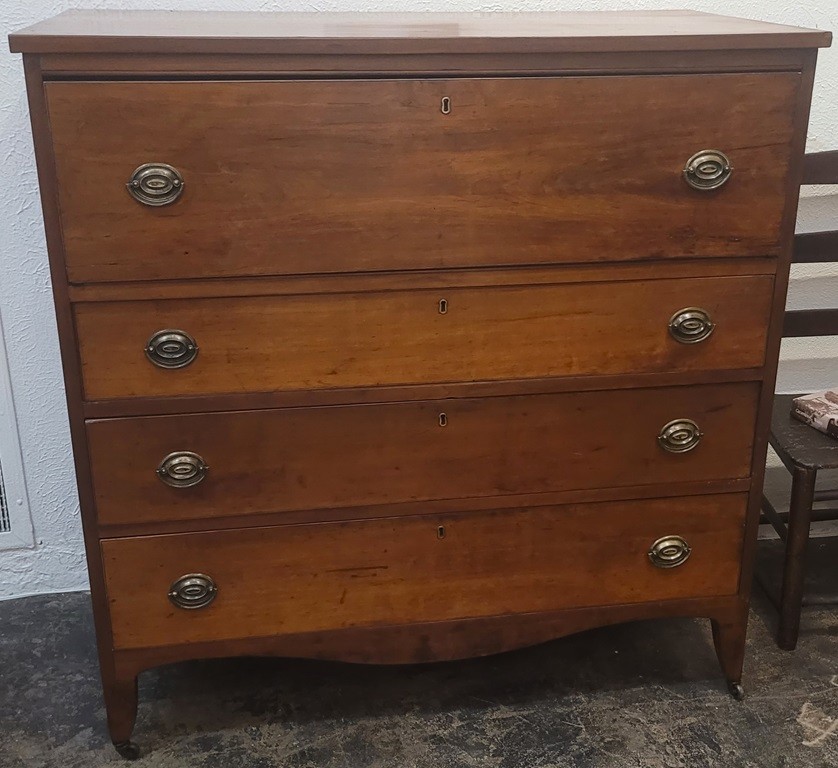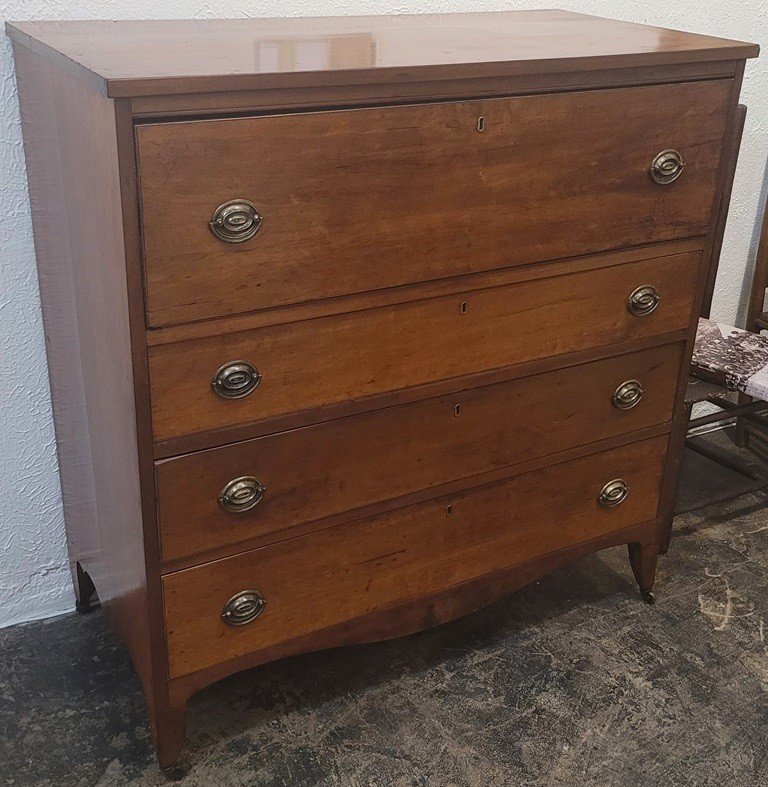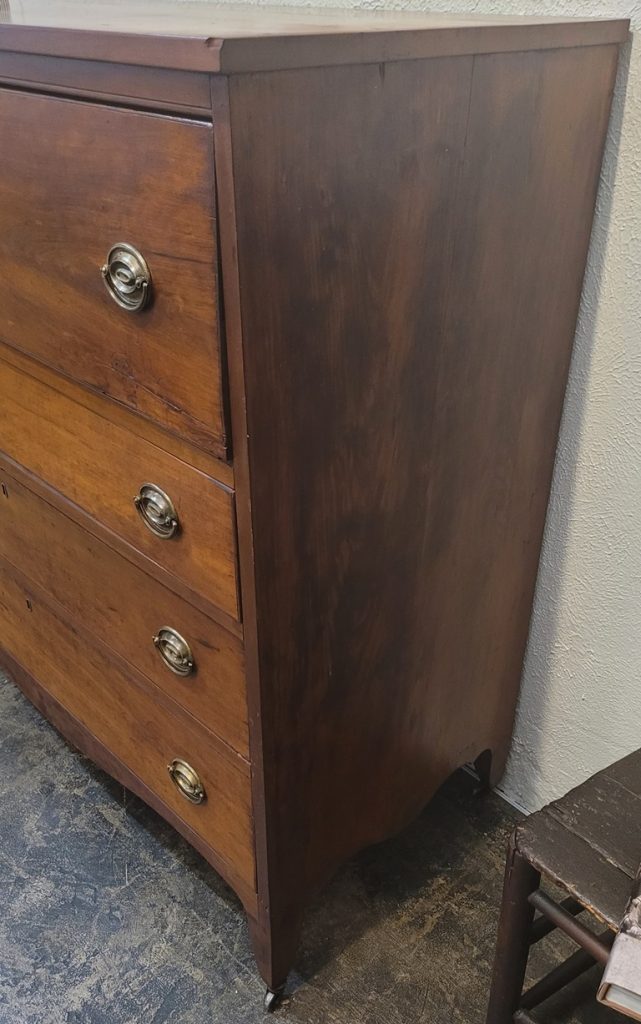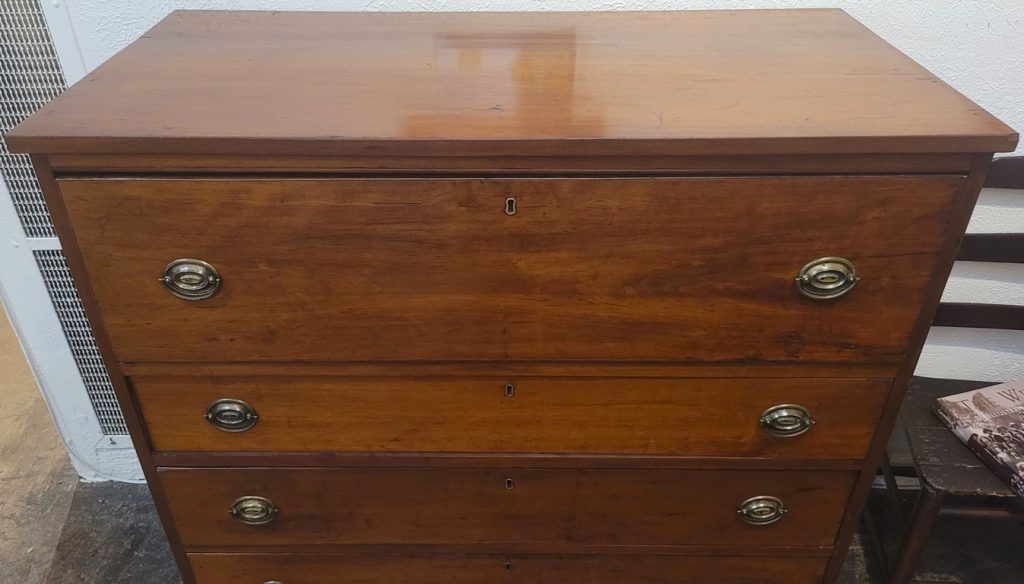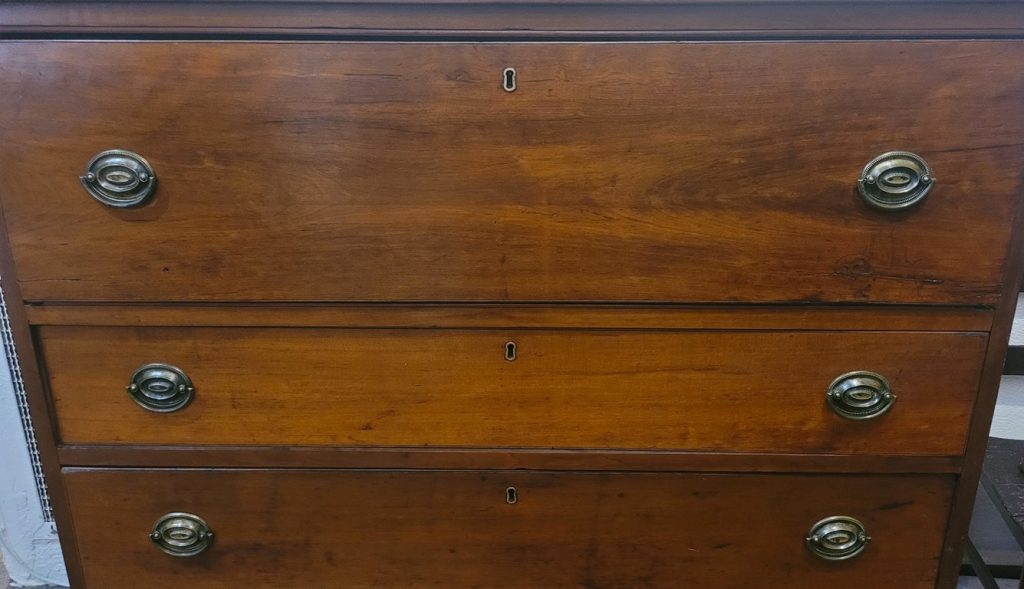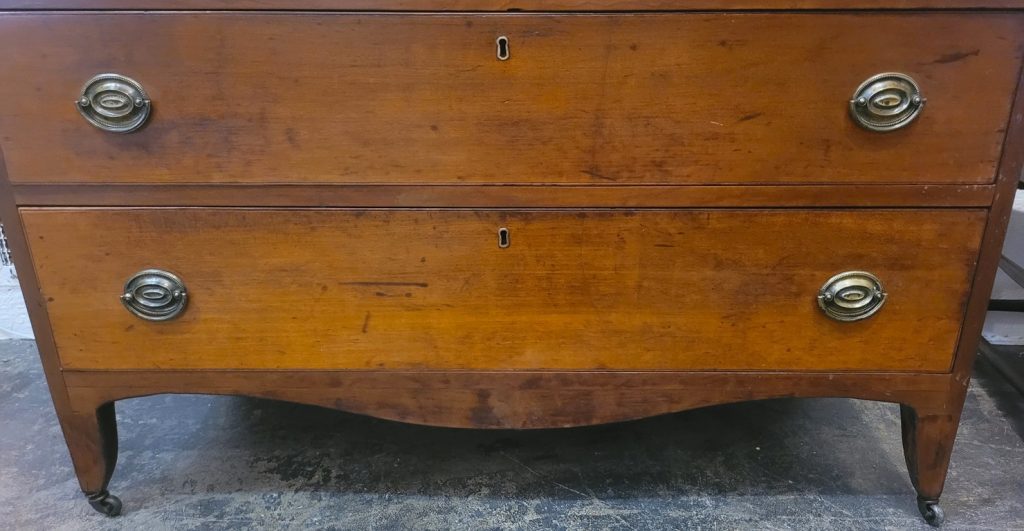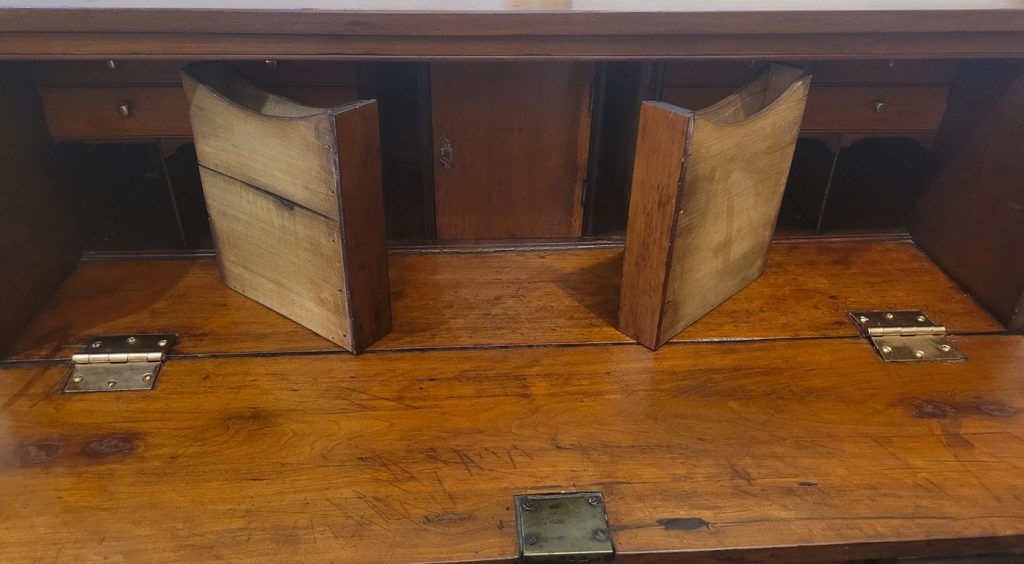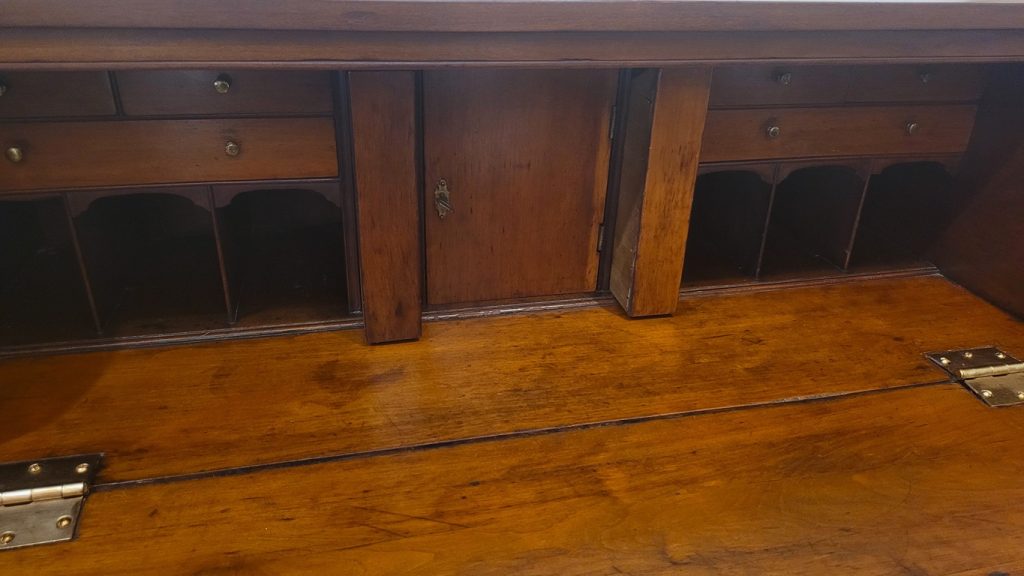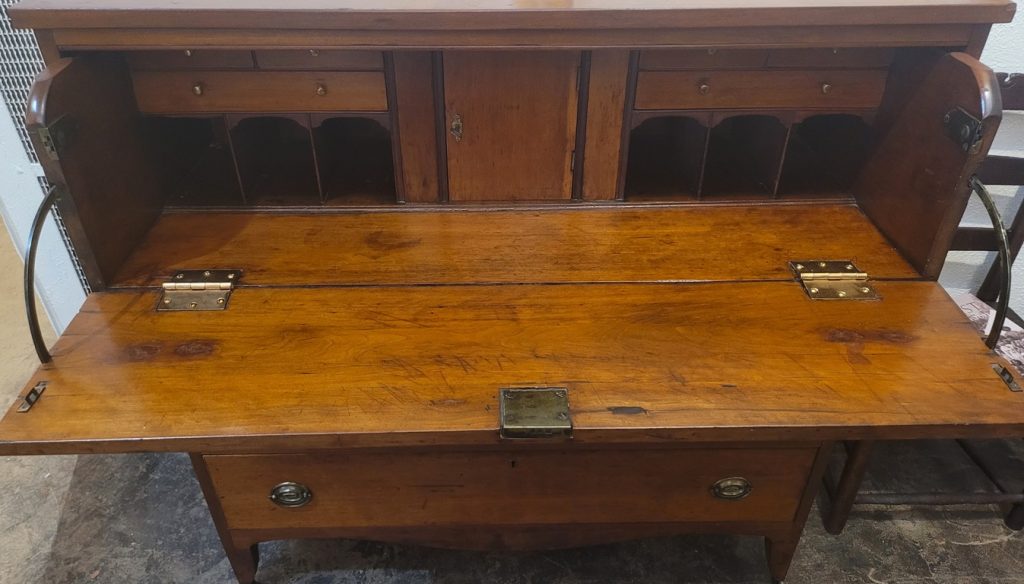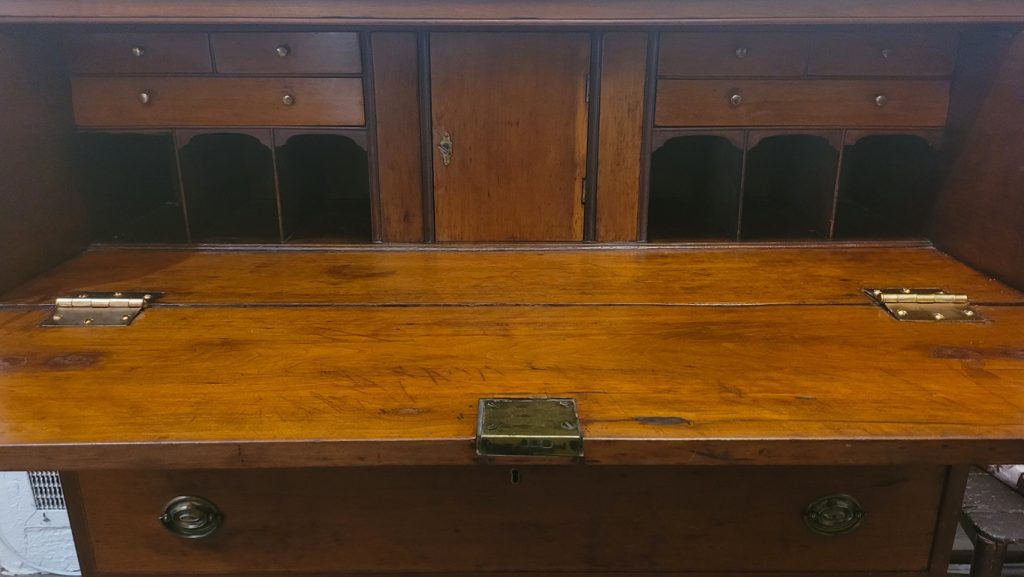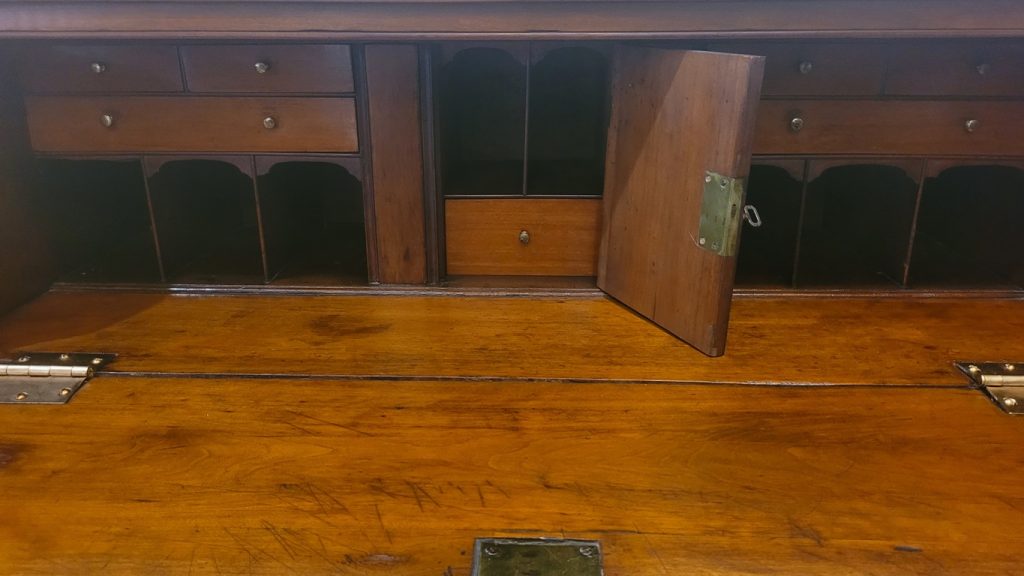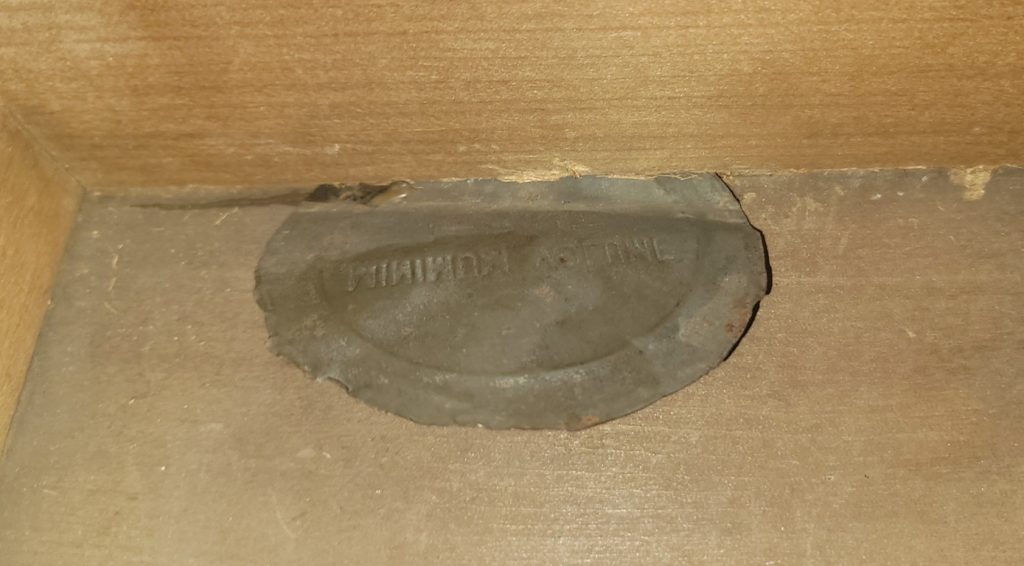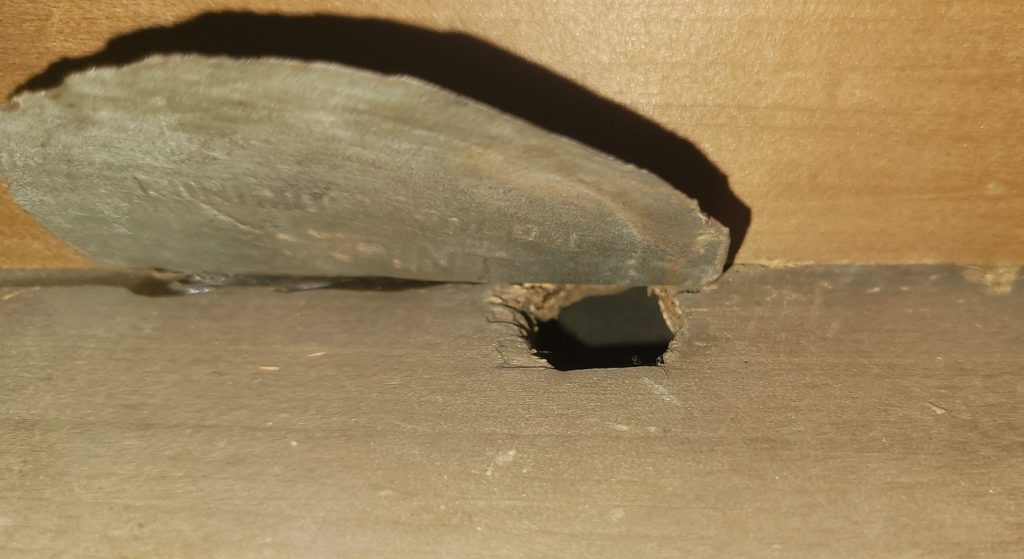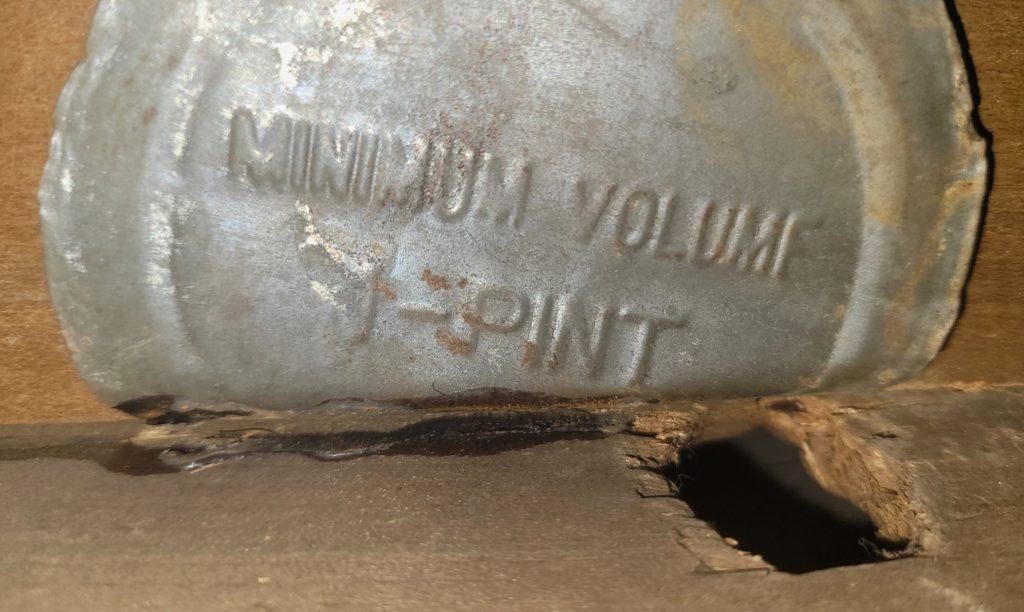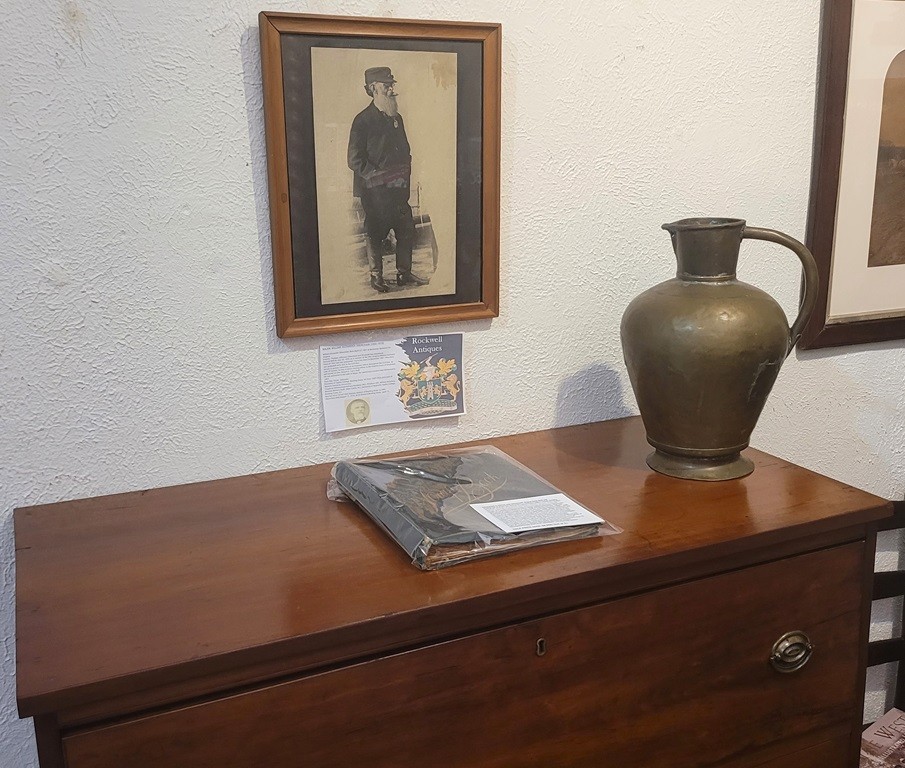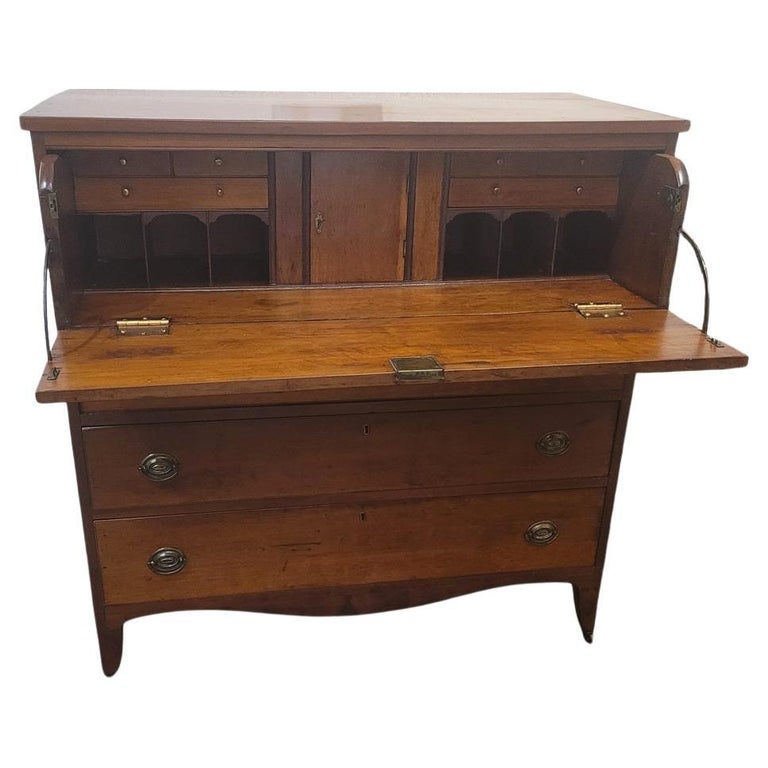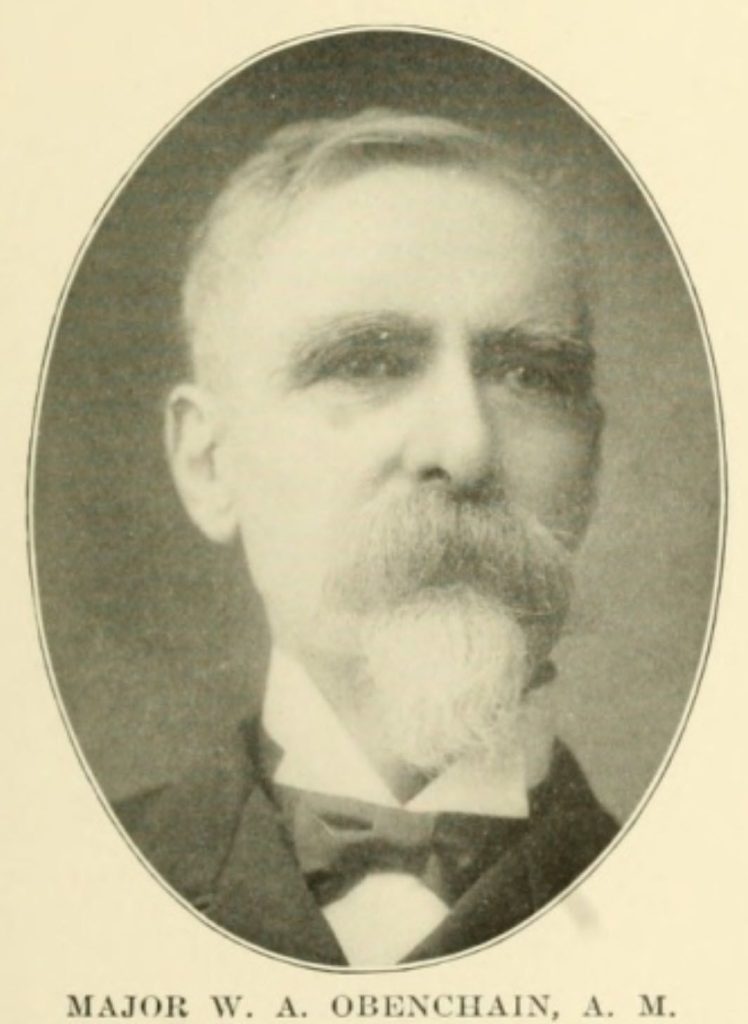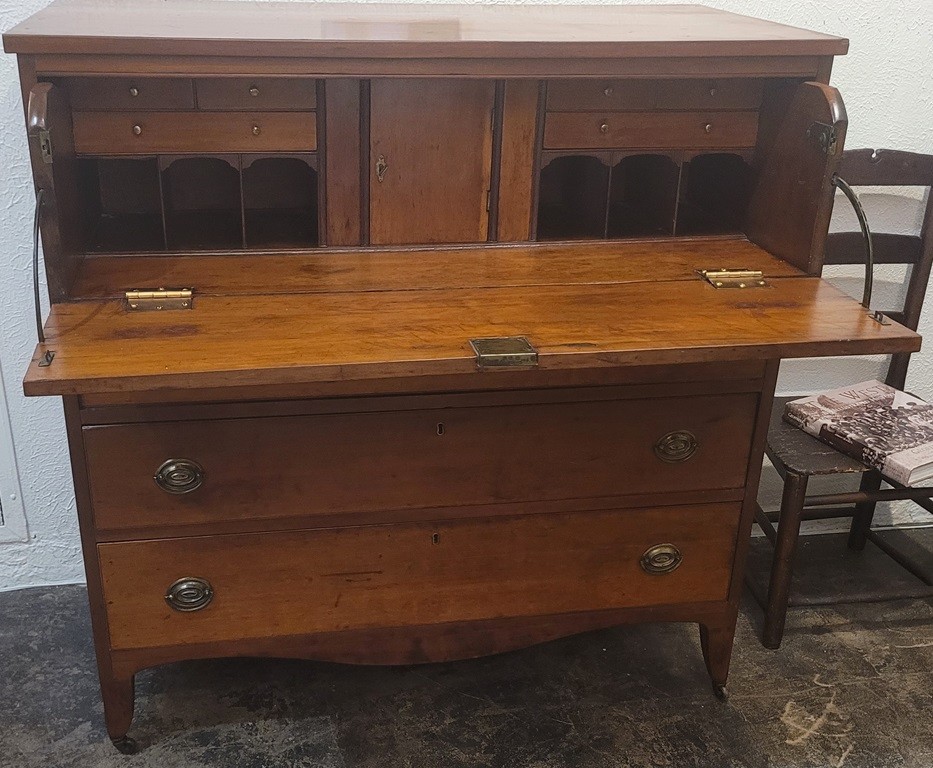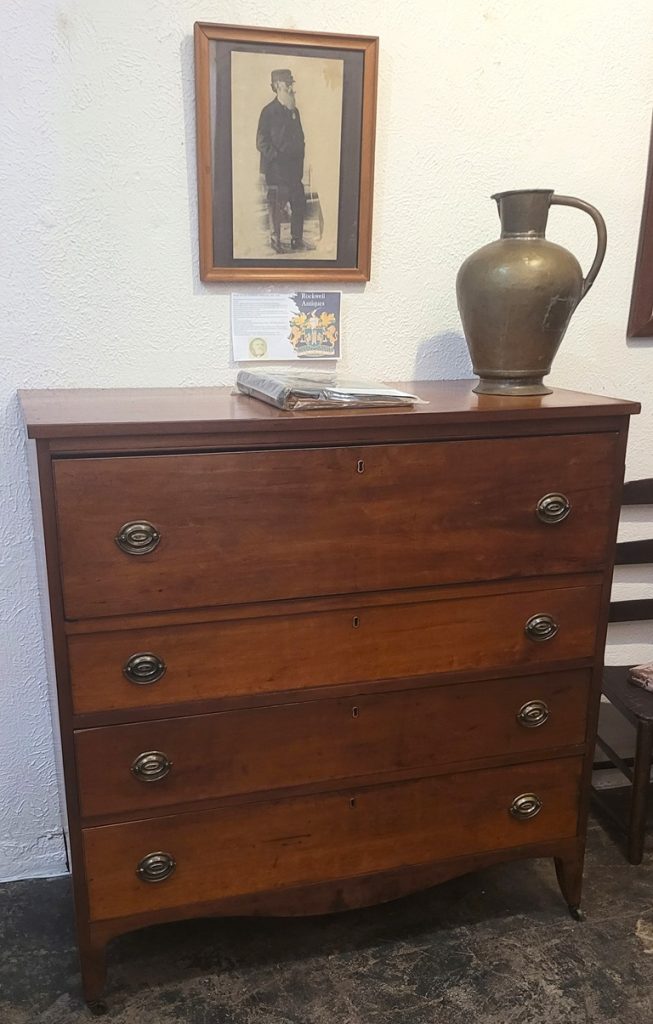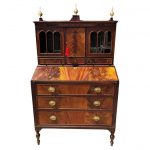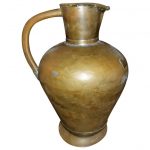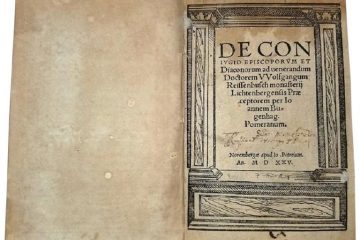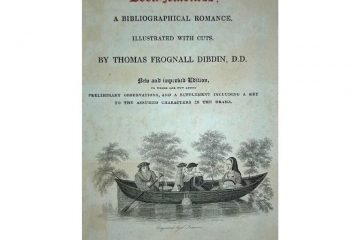American Hepplewhite Virginian Secretary Chest with Civil War Provenance
PRESENTING a FANTASTIC and HISTORIC Early 19C American Hepplewhite Virginian Secretary Chest with OUTSTANDING Provenance.
This Secretary Chest was made in Virginia in the Early 19th Century, circa 1810.
It is made of cherry, walnut and maple and is most definitely in the Hepplewhite Style of the period, with it’s original Hepplewhite brass drawer pulls.
IT IS A REALLY INTRIGUING AND HISTORIC PIECE, ESPECIALLY, WHEN VIEWED IN CONTEXT WITH IT”S AMAZING PROVENANCE!
This piece was originally owned by Major William Alexander Obenchain who ‘hailed’ from the State of Virginia.
He was an engineer and was in the Virginia Corps of Engineers during the Civil War and served on General Robert E. Lee’s staff. It was acquired by him before the Civil War and we believe that this piece was on campaign with him during the War. We know for a fact that he fought at the Richmond Campaign in 1864, as we have, in our Collection, his original Field Map for that Campaign which ended the War.
It has remained in family ownership ever since.
It has come directly from the Family Estate, together with other VERY IMPORTANT items belonging to Major Obenchain and other IMPORTANT items that belonged to his wife, Eliza Calvert Hall-Obenchain. ALL these items contained in the Collection, are listed/posted individually on our Website.
The top drawer is on retractable curved side hinge supports and pulls outwards and drops to reveal a secretary and writing area.
The Bureau/Secretary Gallery has 6 drawers and 6 cubbies, a central tabernacle door with another drawer and 2 cubbies and this is flanked by 2 secret pull out compartments.
The central tabernacle door has it’s original key and working lock.
Closed, it is almost ‘flush’ like the rest of the drawers, with some very minor bowing through age.
The 3 drawers underneath are graduated in size and it ends with a serpentine shaped base and sits on four hand carved legs with original metal casters, marked ‘Universal 3’.
It has it’s original brasses and hardware throughout, save the addition to 2 contemporary replacement brass hinges to the drop down desk front, as the original hinges were broken, could not be repaired and were not supporting the weight of the drop down leaf.
Some minor repairs but not noticeable.
Otherwise, the piece is in it’s entirely, ORIGINAL condition !
What makes this piece even MORE INTRIGUING and APPEALING HISTORICALLY, are the 2 ‘historic’ circular holes on the piece:-
(1) in the back of the piece as seen in the photos. This hole is not symmetrical or fully round and appears to serve no purpose to the piece whatsoever. Sometimes, pieces have holes for wiring for lighting, put in them over the years, but this one never had such lighting or, indeed, any such explanation for this hole, AND
(2) the rear hole is replicated, in the corner portion of the bottom drawer and someone (a very long time ago) has used a tin can top, to cover the hole in the back of the drawer. The tin can top is period to the Civil War Era and is embossed “Minimum Volume 1 Pint”.
Our conclusion, is that (whilst we are, by no means ballistic experts) that these holes were created by musket balls, fired during one of the Major’s campaigns in the Civil War. It is entirely conceivable that this piece, being strapped into a covered wagon for carriage, would have been on it’s side. We are of the opinion that both holes, were caused or created by a musket ball entered the chest trough the base and back. We also believe that ‘the Major’, used what he had at his disposal on the battlefield, namely, a tin can lid to repair the hole in the drawer.
SO THIS PIECE IS A VERY SPECIAL PIECE OF US HISTORY, INDEED!
NOT ONLY IS IT AN EARLY 19th CENTURY AMERICAN PIECE, WITH A CONNECTION TO THE STATE OF VIRGINIA, THE CIVIL WAR, HISTORIC & IMPORTANT FIGURES IN THAT WAR AND IMPECCABLE PROVENANCE AND HISTORY!
IT IS TRULY UNIQUE!
William Alexander Obenchain. Born April 27, 1841 at Buchanan, Botetourt Co., Virginia.
Parents: Thomas Jefferson Obenchain and Elizabeth Ann Sweetland.
Entered VMI on July 18, 1859 as a member of the VMI (Virginia Military Institute) Class of 1862 and was graduated (1st in his class) in December 1861–this class was graduated early due to the Civil War.
Served in various capacities as an Engineer officer throughout the Civil War. At rank of Captain he was a senior ranking officer in the Virginia Corps of Engineers and served on Gen. Robert E. Lee’s Staff.
He was promoted to the rank of Major, for meritorious conduct near Richmond in 1864.
Post-War Career- Educator.
Taught at Hillsborough Military Academy (NC), Pittsboro (NC) Military Academy, Western Military Acad. (New Castle, KY), University of Nashville, Ogden College, Bowling Green, KY.
Married Eliza Calvert Hall (famous Author) of Bowling Green in 1885.
Obenchain died August 17, 1916 at his home in Bowling Green, age 75.
George Hepplewhite (1727? – 21 June 1786) was a cabinetmaker. He is regarded as having been one of the “big three” English furniture makers of the 18th century, along with Thomas Sheraton and Thomas Chippendale. There are no pieces of furniture made by Hepplewhite or his firm known to exist but he gave his name to a distinctive style of light, elegant furniture that was fashionable between about 1775 and 1800 and reproductions of his designs continued through the following centuries. One characteristic that is seen in many of his designs is a shield-shaped chair back, where an expansive shield appeared in place of a narrower splat design.
Very little is known about Hepplewhite himself. Some established sources list no birth information; however a “George Hepplewhite” was born in 1727 in Ryton, County Durham, England. According to some sources, he served his apprenticeship with Gillows in Lancaster, but the Oxford Dictionary of National Biography is sceptical about this. It is known that he based himself in London, where he opened a shop. After he died in 1786, the business was continued by his widow, Alice. In 1788 she published a book with about 300 of his designs, The Cabinet Maker and Upholsterers Guide, with two further editions published in 1789 and 1790.
Many are quick to praise the designer George Hepplewhite, but there are inconsistencies to his fame. The published guide books that claim George Hepplewhite as their author were released after his death by his widow. It was not until years after his death that his designs started to receive recognition. Little is known about the man George Hepplewhite, and only his death certificate seems to offer any hard evidence of his existence. The question arises whether “George Hepplewhite” was a real person or just a name for Alice Hepplewhite to publish under.
With contemporaries such as Thomas Chippendale producing pieces in a variety of styles, Hepplewhite’s famed style is more easily identifiable. Hepplewhite produced designs that were slender, more curvilinear in shape and well balanced. There are some characteristics that hint at a Hepplewhite design, such as shorter more curved chair arms, straight legs, shield-shape chair backs, all without carving. The design would receive ornamentation from paint and inlays used on the piece.
The book influenced cabinet makers and furniture companies for several generations. The work of these generations influenced in turn copies of the original designs and variants of them through the 19th and 20th centuries.
Link: https://en.wikipedia.org/wiki/George_Hepplewhite
“As we know it, the Hepplewhite chest of drawers is distinguished by the French splayed foot, curved apron and bow or serpentine front. All are to be found in the Guide designs as well as others in the Adam manner and one or two distinctly French in inspiration. Plate 76 shows two chests of drawers, one with a serpentine and the other with a bow front typical of many made in both England and the United States.
Relatively few American Hepplewhite pieces were made entirely of satinwood. Our cabinetmakers often used it for decorative veneer and had at their command another light colored wood that they used almost as effectively. This was maple, either curly or bird’s-eye. Some of the most successful pieces, particularly those of New England origin, were the result of the contrast between mahogany and fancy-grained maple.”
FOR MORE: https://www.collectorsweekly.com/articles/hepplewhite-combined-straight-lines-and-bold-curves/
American Hepplewhite Virginian Secretary Chest with Civil War Provenance
Provenance: From the Estate of Major W.A. Obenchain.
Condition: Very good overall. 2 new hinges added to drop down desk front. Some minor repaired cracks, blemishes etc from age and use. No key. Otherwise in very good ORIGINAL condition.
Dimensions: 44.25 inches Tall, 42.75 inches Wide and 20.25 inches Deep with secretary drawer closed.
33.25 inches Deep with secretary drawer fully open. Knee Clearance on desk is 32.2 inches.
SALE PRICE NOW: $16,000


